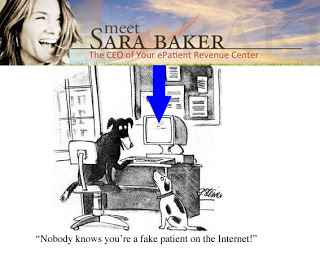Last night I had the honor of hosting the #socpharm “Tweetchat” session, standing in for Eileen O’Brien (@EileenObrien; Siren Interactive) who is the founder and regular host of that Twitter discussion stream.
One issue discussed in last night’s session was Sara Baker, a “fake” patient created by MedSeek, a health IT company (see Lori Moore’s comment to this post).
“Meet Sara Baker,” says MedSeek on its website. “ePatients like Sara Baker are the future of eHealth. She uses the Internet to stay connected with friends, check her bank balance and make purchases. She is Web-savvy and expects her healthcare provider to be, too. She has growing expectations of her healthcare providers for 2011 and beyond. And she will be the driving force behind your healthcare organization’s ePatient revenue center.” [emphasis added]
MedSeek even created a Facebook page/personna (eSaraBaker) for Sara where she posts things like “Just found out my hospital is adding a new online feature starting June 1: Now I’ll be able to log in one time to manage everybody’s appointments, prescriptions, etc. Me, Alex, Brad and Jake… all in one place. How great is that?”
Phil Baumann (@PhilBaumann) first called attention to this marketing ploy that “promises to deliver revenues to healthcare organizations wishing to market to so-called ePatients.” Baumann coined the term “fPatient” to distinguish the likes of Sara from real ePatients (see “fPatient – Ethics and Mediocrity in Healthcare Marketing“).
The #socpharm discussion of Sara Baker lead to a discussion of the use of “fake” patients on drug.com websites, something I have written about many times here on Pharma Marketing Blog. See, for example, “Alice, 35, is Not a Real Ambien CR Patient.” After I wrote that piece, sanofi-aventis added the disclaimer “Not a real patient” to the animation on the site. Since then, however, they have moved away from images of “fPatients” to roosters. Oh well.
The trend today, however, is to solicit and portray real patient stories. See, for example, “Barb” on the Novartis Reclast site. She’s featured in a “Dramatic Health Production” video in the “Real Reclast Stories” section of the website (here).
Although Barb is real, there are other “patients” featured on the website who may not be real. Take “Rhoda” for example. There’s a written profile of Rhoda, but I can’t find her in the “Real Stories” section. Is she real or fake? I can’t say for sure one way or the other.
Obviously, actors are used in direct-to-consumer (DTC) Rx drug ads all the time. Sometimes, we are lead to believe that actors playing doctors in TV ads are real doctors or actually rowing when they are not (see “Jarvik: A Modern DTC Tragedy“). On TV we also see actors portraying patients. Sometimes they even speak and say how the drug helped them. Most often, however, these “patients” don’t really say anything. They certainly are not identified by name and age as is the case with “Rhoda” and other questionable “patients” on drug.com websites.
Is it ethical for pharma marketers to employ “fpatients?” Is it even necessay? asks Baumann: “Is the deployment of fake profiles in Healthcare Marketing even necessary? Marketing not only has to be effective, it also has to be respectable. Why create a fake social object when so much more social capital can be built by simply being honest and truthful and direct? Why not take advantage of direct interaction and feedback?”
We might have to wait until hell freezes over before pharma marketers are “honest and truthful and direct” let alone before they “take advantage of direct interaction and feedback.” Like the Reclast marketers, however, pharma marketers will go on location to videotape a real patient and create a well-crafted, edited video profile that they can feature on their websites and on YouTube for extra-added search engine benefit. You can’t get that kind of ROI from “truthful, direct, honest interaction.”









![6 Digital Tools at the Center of Healthcare Digitalization [INFOGRAPHIC]](http://ec2-54-175-84-28.compute-1.amazonaws.com/pharma-mkting.com/wp-content/uploads/2021/04/6DigitalTools_600px-100x70.jpg)




